SKOVENS ARENA
A team of British architect Zaha Hadid in close collaboration with architecture and engineering consultancy Sweco and Tredje Natur architects has won the competition of ...
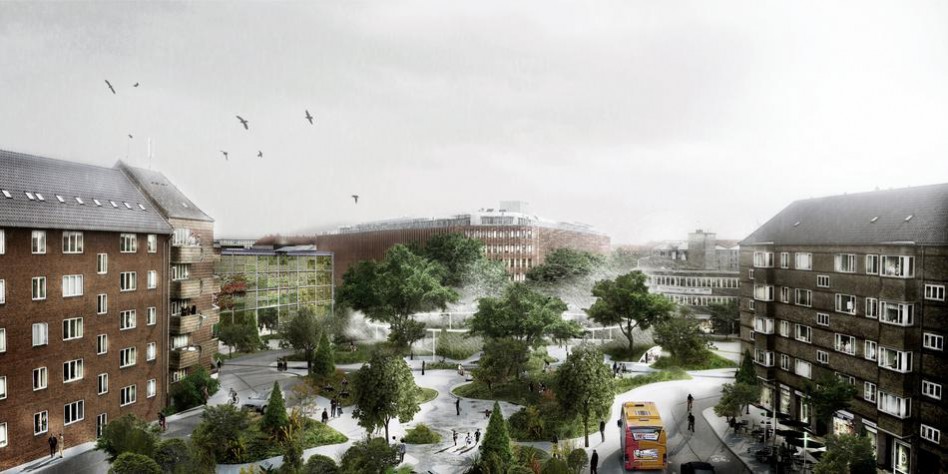
Read our own Press release
Responsible partners: Flemming Rafn Thomsen and Ole Schrøder
Design team: Monica Galiana, Anna Sissela Michalsdottir, Joan Melgaard Rasmussen, Lotte Randeris Kristensen, Louise Fiil Hansen and Hans H. Bærholm
Location: Skt. Kjelds District. Outter Østerbro in Copenhagen
Cliet: Copenhagen municipality at Center for Park and Nature, Area renewal Skt. Kjelds District, Copenhagen Patios, Copenhagens energu and Environment Østerbro.
Area: 105 Ha
Project period: 2011-16
Prizes: Guangzhou International Award for Urban Innovation, 2016
Read about Sustainia100
Follow the laastest news on the Climate District
(All links provided in Danish)
The greatest challenge of all lies in the existing city. The objective is to upgrade the city in relation to the citizen’s expectations in terms of what the city can provide in sustainability, sociability, and in regards to health. The idea is that having a coherent and natural design will create the most sturdy strategy. This will be the key to a holistic district, as well as sensibility for individual spaces, areas and for the people. – Partner in Trejde Natur, Ole Schrøder
How do we combine city and nature in a third coherent state? How can we create an understatement for the natural phenomenon and resources by having a city with climate adaption? How can we experience the lights of the city without lampposts and lamps? How can we hear nature’s sounds amongst the noise of the traffic? In St. Kjelds district all these questions are catalysors for the thoughts and the design of Bryggervangen, St. Kjelds square, Tåsinge square and the courtyards. We aim to create a unique performative city-nature which increases the city’s value and the recreational and extrasensory possibilities.
What we request of the city are events – both social and commercial. There are several urban activities, interesting residential areas, convenience stores, daycare centers, etc. In addition, there are several urban open spaces, places to meet, places for recreational activities, and places where you can just sit and enjoy the sun and the life around the city. On the other hand the nature represents the opposite. We seek nature for peace, for contrast and nature’s presence, along with the recreational aspect and the irregularity.
In Denmark it rains 121 days a year. A typical drainage channel is conventionally dry 95% of the time. Therefore the channel has to be able to take advantage of the frequency of the downfall and increase the longevity of it in the positive urban space. The thought is to keep the water longer in urban spaces for recreational activities, along with other urban purposes for when the spring has dried out. The water can be used in form of artificial puddles, flow through Wadi’s, or be stored for dry periods. When the area has dried out, it can be used for bypassing or a place for a temporary stay.
Bryggervangen is a central street in the districts climate resilience. Tredje Natur calls the course The Green Spring, taking Kildervældsparken into consideration along with the water gushing into the street. St. Kjelds district makes up a catchment peaking south of St. Kjelds Square and is an ideal water drainage solution. By optimizing the parking lots placement and the width of the street, room is created for water drainage, nature and new bicycle paths. Countless unutilised spaces have the potential to create a handfull of urban areas, not taking St. Kjelds Square and Tåsinge Square into account.
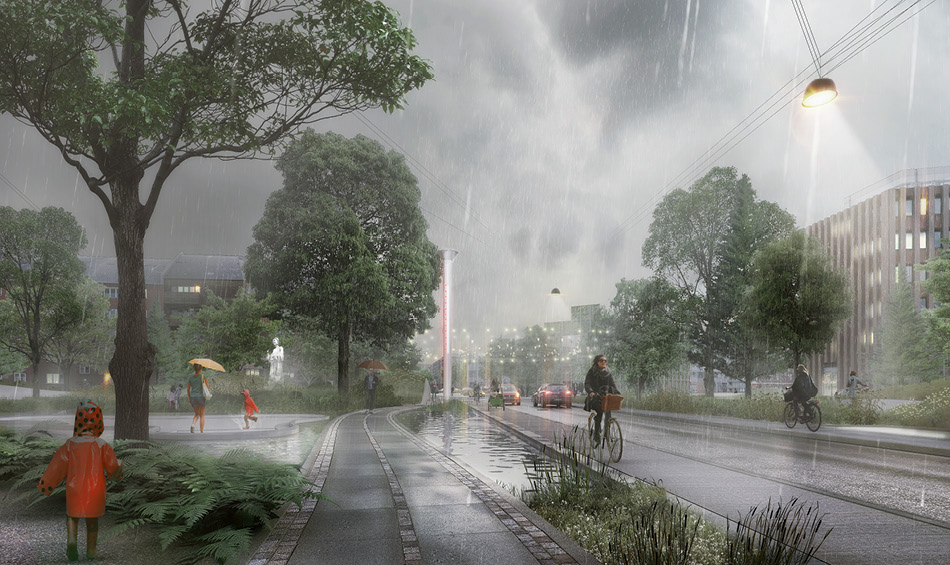

In this area 7 streets merge in a 8.000 m2 delimited urban space. The square is the physical midpoint and should in the future pose as the natural meeting and gathering place of the district. Considering the central location and size, it has potential as a showcase and to display the climatic district, both nationally and internationally. The area is inspired by the dead-ice landscape, which occurs naturally several places around Denmark. During the ice age, the ice was withheld underground in pockets which slowly melted and left characteristic recess in the surface of the earth. Here there is an atypical variation in the terrain compared to the normal pancake flat Denmark.

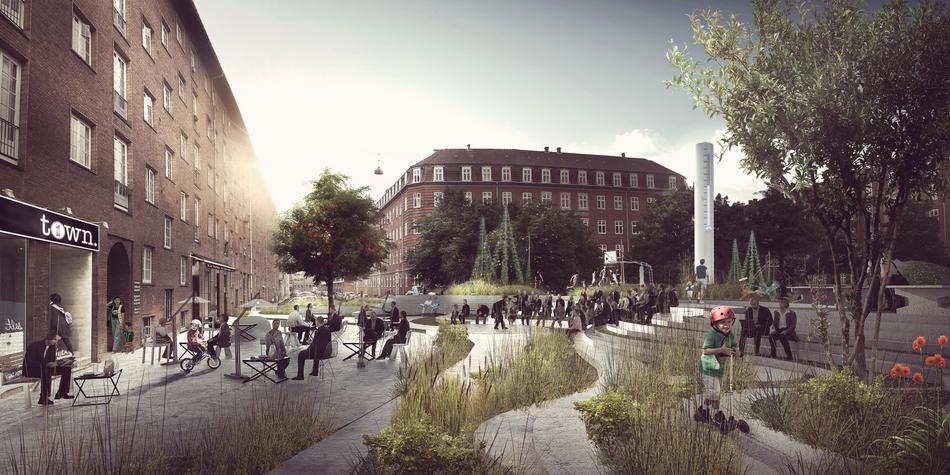
Storing the rainwater is a part of Copenhagen’s climate adaption strategy.The water falling from the sky is clear and does not contain calcium like our potable water. Today a large amount of the rainwater goes directly into the sewer. This does not only take up a lot of resources, but the sewer system also overloads due to the enormous amount of rainwater coursed by climate changes. The idea is to store the water using the clean downfall from the rooftops. The downspouts are connected to the gutter’s which can, by use of gravity, be pumped up into silo’s as tall as the buildings all around the district.


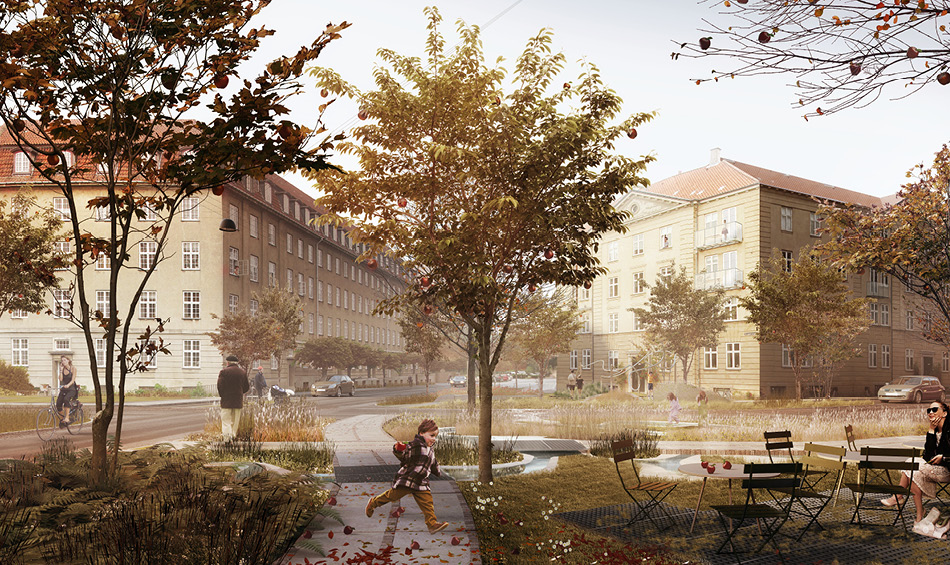
Today the area is mostly known for its thoroughly marked asphalt areas and there is great potential in thinking of this 4.300 m² urban delimited area as a conjoined surface for development. In the southeastern corner a café can be established and in the northwestern area there is sun throughout the most of the day.
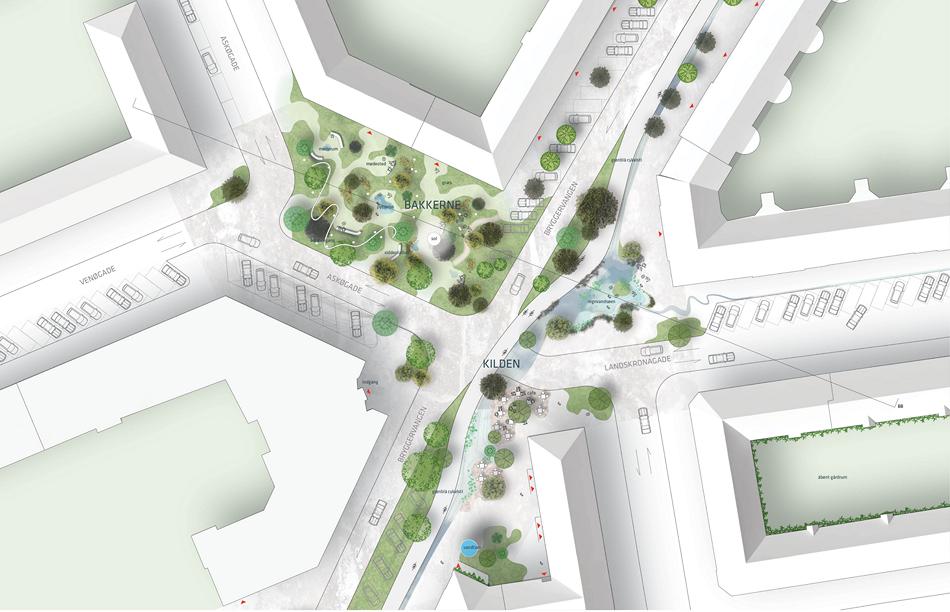

The projects in the climate district shows that it is possible to create a technical solution to draining the rainwater which leads the water into the harbours instead of our basements. At the same time we can incorporate all the features which makes an area aesthetically desirable, implement green streets and form urban spaces. It is architecture that combines the technical and aesthetics in a new and exciting way – Tina Saaby, municipal architect in Copenhagen Municipality
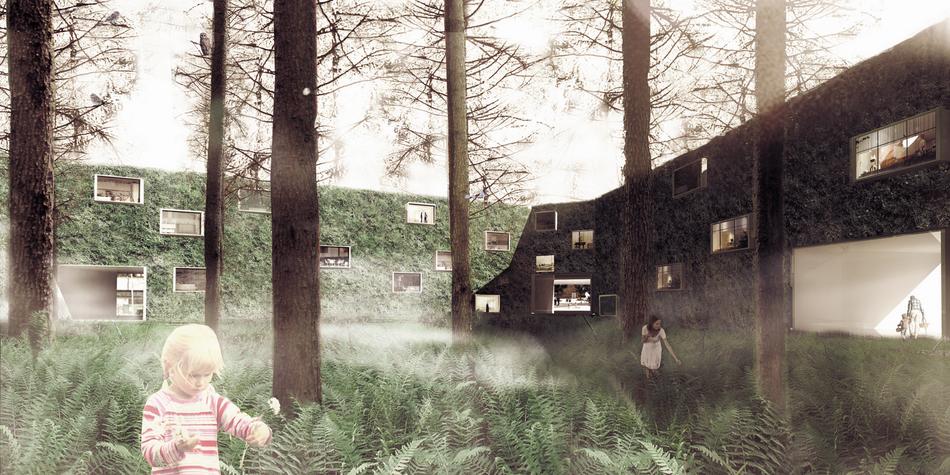
Energy Renewal is a separate and thorough project, which concerns the entire existing residential area. The idea is that a larger intervention can exploit the rainwater and vegetation innovatively to a coherent energy renewal plan, using green and blue facades. At the same time the collected rainwater can be used for household purposes and be a local as well as sustainable solution which can help solve the climate challenges in other parts of the city.
A team of British architect Zaha Hadid in close collaboration with architecture and engineering consultancy Sweco and Tredje Natur architects has won the competition of ...
We have created 'Undergrowth' - a vision for transforming Kongelunden in Aarhus, Denmark. With Undergrowth we have made a regenerative strategy that supports nature’s ability ...
The future neighbourhood – Lynetteholm – will be a vital part of the climate- and flood protection of Copenhagen and create space for more than ...
In THE BLUE RAMPARTS, we have worked with the area Damsterdiepzone in Groningen - an area that accommodates industry, housing, and businesses. In our vision ...
Ugakei Circles is a sustainable tourism project located on the fringe of one of Japans most populated areas. The project marks a new shift towards low impact regenerative tourism
In a new grand vision for the 40-hectare future development area, Dokken in Bergen, Norway, Third Nature shows high ambitions for the regenerative city in an old logistics port and ferry terminal.
The historical Enghavepark has been transformed and is now the biggest climate project in Copenhagen. With a 22.600 m3 water reservoir, the park is answering a need to handle Copenhagen's current and future challenges with water.
The Norra Bunkeflo area in Malmö, Sweden, can become a sustainable model example for the realization of the UN's World Goals and how we can live up to the 2030 goals of the Paris Agreement.
‘New Angle’ shows how the SDG’s can be translated into practice in the construction industry. It is estimated that the project represents a CO2 saving of 30-50%.
With CPH Common House we propose the world's first upcycled high-rise building
With our master plan for Adamstuen in Oslo, we show that it is not necessary to make a compromise between building and biology in order to achieve an architectural balance in a master plan
ARKENWALK is an ambition to unite art and city with a path that anchors Arken Museum as the town’s urban generator
With the proposal `Karnappen' we have created a distinctive landmark with a green and vibrant facade for Grønttorvet in Valby, Copenhagen
The isolated Vridsløselille State Prison is rethought inside out to become an active and integrated part of the surrounding city life in Albertslund
THIRD NATURE and COWI have made a feasibility study for the City of Copenhagen, highlighting the possibilities and consequences of establishing a traffic tunnel below Åboulevarden
New Islands Brygge School has the potential to become a new and highly interconnected link between the harbor, the nature and the city
The Water Culture House integrates water activities with the cultural and popular everyday life by the harbor and creates unique and distinctive experiences
We create a new and green gathering point in Hyllie that with a station building, housing and a station square strenghtens a livable, diverse and vibrant city life
THIRD NATURE releases a groundbreaking solution to major cities' challenges with flooding, parking and lack of green spaces
With Kunskabsberget, TREDJE NATUR has designed an open, safe and flexible learning environment, with a clear local presence
Værløse Airfield has great potential for creating a grounded everyday life with nature at its core
TREDJE NATUR have created a new masterplan for “Svanemøllens Kaserne” with an understanding of the areas special history as its starting point
The station at Klostergården is a visionary infrastructural project that shows how the construction of a new station can lift up and rethink an entire neighborhood in a city
In the heart of Nordhavn lies the historic port of Copenhagen, Kronløbsøen. A new island rising from the harbour as an alluring mirage
TREDJE NATUR has together with C.F. Møller and Rambøll come up with a new holistic vision for a close sustainable Gustavsberg from the basis of the place’s original and forgotten nature.
TREDJE NATUR and C.F. Møller wins The Future Sølund. Along with Bascon, Transsolar and Smith Innovation they draw and will build one of the largest and most visionary residential projects seen in the history of Denmark
Papirøen has a unique placement in at the inner part of Copenhagen harbour. There is a lot of potential on this prime location setting the bar high on the subject of Copenhagen future city- and nature developments.
TREDJE NATUR have designed a proposal for a new pedestrian and cyclist bridge in Sydhavnen
TREDJE NATUR wins ambitious project on Nordhavn's best building site. On the tip of Redmolen surrounded by water on three sides, a prestige building and urban space is now in the making.
CBS in the city - The city in CBS! Our dogma is about developing CBS as a campus that is integrated into the city
TREDJE NATUR continues to build on the Copenhagen climate adaption plan, and joins the water investment with new strategies for nature, life and community in the city.
Vinge is not just inspired by nature, it is a city which works with nature’s processes and creates nature.
TREDJE NATUR's plan revives Bryggens Bastion with green and blue elements as the central values in the neighborhood. A connecting corridor in the project becomes the neighborhood’s new hub.
TREDJE NATUR won 2nd place in the Middelfart Climate City competition, along with Entasis and Grontmij.
TREDJE NATUR designs a collaborative platform presenting new solutions to future water challenges
Our winning proposal for the development of Almegård Barracks is based on a holistic, local concept where the main transformative force is found in the individual users and inherent qualities of the site.
Tredje Natur thinks Copenhagen’s Harbor should be a lively, accessible, productive and recreational area in the city.
The climate district in Østerbro shows the climate adaption of the future and the development of the existing city.